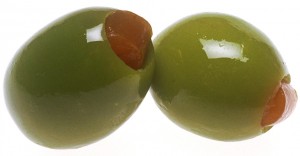 Although most consider the olive a vegetable, its actually a fruit. Many consume green and black olives, the only difference between the two being their degree of ripeness – green being the less ripe. Olives are usually prepared by being cured or pickled in oil, water or brine, or even soaked in lye. Olives have been regarded as a symbol of wisdom, peace, sustenance, and medicine in many civilizations over the years. It is thought that olives originated in Crete between 3,000 and 5,000 B.C.E., and then spread to the Americas by Iberian explorers during the 1400s. Today, olives are still a staple in the Mediterranean diet, and have grown in popularity as more research shows their amazing health benefits.
Although most consider the olive a vegetable, its actually a fruit. Many consume green and black olives, the only difference between the two being their degree of ripeness – green being the less ripe. Olives are usually prepared by being cured or pickled in oil, water or brine, or even soaked in lye. Olives have been regarded as a symbol of wisdom, peace, sustenance, and medicine in many civilizations over the years. It is thought that olives originated in Crete between 3,000 and 5,000 B.C.E., and then spread to the Americas by Iberian explorers during the 1400s. Today, olives are still a staple in the Mediterranean diet, and have grown in popularity as more research shows their amazing health benefits.
Nutritional Highlights:
- Olives and their oil are excellent sources of oleic acid, an omega-9 monounsaturated fatty acid.
- They also contain mixed tocopherols, vitamin E, oleuroprein, and flavonoids.
Health Benefits:
- Consuming olive oil in place of saturated animal fats can prevent against the oxidation of cholesterol, helping to prevent atherosclerosis.
- Studies have shown that those who eat olive oil gain better blood sugar control and lower levels of triglycerides, helping to regulate diabetes.
- Also, heart disease risk can be lowered with olives due to their high antioxidant levels, which help prevent against the oxidization of cholesterol.
- Olive oil is effective at lowering systemic inflammation, and has been shown to help prevent asthma, arthritis, and cancer.
- Recent studies are showing that the oleic acid found in olive oil can significantly cut the levels of a breast cancer-promoting gene by up to 46 percent.
At any family occasion, olives are always present as an appetizer. Mix it up by making an olive tapenade this year. A favorite recipe of mine is to puree olive oil, garlic, and a bean of choice in a food processor. Season to taste and serve as a dip or spread. Check out my “Encyclopedia of Healing Facts” for more olive serving ideas.


